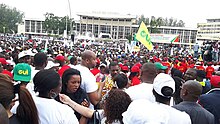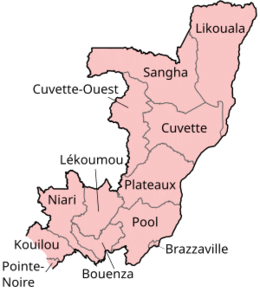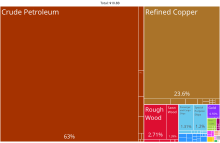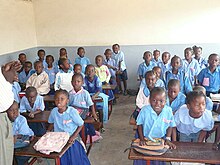The Republic of the Congo[a] is a country located on the western coast of Central Africa to the west of the Congo River. It is bordered to the west by Gabon, to the northwest by Cameroon, to the northeast by the Central African Republic, to the southeast by the Democratic Republic of the Congo, to the south by the Angolan exclave of Cabinda, and to the southwest by the Atlantic Ocean.
Republic of the Congo | |
|---|---|
| Motto: "Unité, Travail, Progrès" (French) (English: "Unity, Work, Progress") | |
| Anthem: "La Congolaise" (French) Besi Kôngo (Kongo) (English: "The Congolese") | |
| Capital and largest city | Brazzaville 4°16′S 15°17′E / 4.267°S 15.283°E |
| Official languages | French |
| Recognised national languages | |
| Religion (2020)[2] |
|
| Demonym(s) | Congolese |
| Government | Unitary semi-presidential republic under a dominant-party authoritarian state[3][4][5][6] |
| Denis Sassou Nguesso | |
| Anatole Collinet Makosso | |
| Legislature | Parliament |
| Senate | |
| National Assembly | |
| Independence | |
• Republic established | 28 November 1958 |
• from France | 15 August 1960 |
| Area | |
• Total | 342,000 km2 (132,000 sq mi) (64th) |
• Water (%) | 3.3 |
| Population | |
• 2023 estimate | 5,677,493[7] (116th) |
• Density | 17/km2 (44.0/sq mi) |
| GDP (PPP) | 2023 estimate |
• Total | |
• Per capita | |
| GDP (nominal) | 2023 estimate |
• Total | |
• Per capita | |
| Gini (2011) | 40.2[9] medium |
| HDI (2021) | medium (154th) |
| Currency | Central African CFA franc (XAF) |
| Time zone | UTC+1 (WAT) |
| Date format | dd/mm/yyyy |
| Driving side | right |
| Calling code | +242 |
| Internet TLD | .cg |
The region was dominated by Bantu-speaking tribes at least 3,000 years ago, who built trade links leading into the Congo River basin. Congo was formerly part of the French colony of Equatorial Africa.[13] The Republic of the Congo was established on 28 November 1958 and gained independence from France in 1960. It was a Marxist–Leninist state from 1969 to 1992, under the name People's Republic of the Congo. The country has had multi-party elections since 1992, but a democratically elected government was ousted in the 1997 Republic of the Congo Civil War. President Denis Sassou Nguesso, who first came to power in 1979, ruled until 1992 and then again since after his reinstatement.
The Republic of the Congo is a member of the African Union, the United Nations, La Francophonie, the Economic Community of Central African States, and the Non-Aligned Movement. It has become the 4th-largest oil producer in the Gulf of Guinea, providing the country with a degree of prosperity, with political and economic instability in some areas, and unequal distribution of oil revenue nationwide. Its economy is dependent on the oil sector,[14] and economic growth has slowed since the post-2015 drop in oil prices. Christianity is the most widely professed faith in the country.
Etymology
It is named after the Congo River whose name is derived from Kongo, a Bantu kingdom which occupied its mouth around the time the Portuguese first arrived in 1483[15] or 1484.[16] The kingdom's name derived from its people, the Bakongo, an endonym said to mean "hunters" (Kongo: mukongo, nkongo).[17]
During the period when it was colonized by France, it was known as the French Congo or Middle Congo. To distinguish it from the neighboring Democratic Republic of the Congo, it is sometimes referred to as Congo (Brazzaville), Congo-Brazzaville, or Little Congo.[18] Brazzaville derives from the colony's founder, Pierre Savorgnan de Brazzà, an Italian nobleman whose title referred to the town of Brazzacco, in the comune of Moruzzo, whose name derived from the Latin Brattius or Braccius, both meaning "arm".[19]
History
Bantu-speaking peoples who founded tribes during the Bantu expansions mostly displaced and absorbed the earlier inhabitants of the region, the Pygmy people, about 1500 BC. The Bakongo, a Bantu ethnic group that occupied parts of what later is Angola, Gabon, and the Democratic Republic of the Congo, formed the basis for ethnic affinities and rivalries among those countries. Some Bantu kingdoms—including those of the Kongo, the Loango, and the Teke—built trade links leading into the Congo Basin.[20]
The Portuguese explorer Diogo Cão reached the mouth of the Congo in 1484.[21] Commercial relationships grew between the inland Bantu kingdoms and European merchants who traded in commodities, manufactured goods, and people captured and enslaved in the hinterlands. After centuries as a central hub for transatlantic trade, direct European colonization of the Congo river delta began in the 19th century, subsequently eroding the power of the Bantu societies in the region.[22]

The area north of the Congo River came under French sovereignty in 1880 as a result of Pierre de Brazza's treaty with King Makoko[23] of the Bateke.[21] After the death of Makoko, his widow Queen Ngalifourou upheld the terms of the treaty and became an ally to the colonizers.[24] This Congo Colony became known first as French Congo, then as Middle Congo in 1903.
In 1908, France organized French Equatorial Africa (AEF), comprising the Middle Congo, Gabon, Chad, and Oubangui-Chari (what later is Central African Republic). The French designated Brazzaville as the federal capital. Economic development during the first 50 years of colonial rule in Congo centered on natural-resource extraction. Construction of the Congo–Ocean Railway following World War I has been estimated to have cost at least 14,000 lives.[21]
During the Nazi occupation of France during World War II, Brazzaville functioned as the symbolic capital of Free France between 1940 and 1943.[25] The Brazzaville Conference of 1944 heralded a period of reform in French colonial policy. Congo "benefited" from the postwar expansion of colonial administrative and infrastructure spending as a result of its central geographic location within AEF and the federal capital at Brazzaville.[20] It had a local legislature after the adoption of the 1946 constitution that established the Fourth Republic.
Following the revision of the French constitution that established the Fifth Republic in 1958, AEF dissolved into its constituent parts, each of which became an autonomous colony within the French Community. During these reforms, Middle Congo became known as the Republic of the Congo in 1958[26] and published its first constitution in 1959.[27] Antagonism between the Mbochis (who favored Jacques Opangault) and the Laris and Kongos (who favored Fulbert Youlou, the first black mayor elected in French Equatorial Africa) resulted in a series of riots in Brazzaville in February 1959, which the French Army subdued.[28]
Elections took place in April 1959. By the time the Congo became independent in August 1960, Opangault, the former opponent of Youlou, agreed to serve under him. Youlou, an avid anti-communist, became the first President of the Republic of the Congo.[29] Since the political tension was so high in Pointe-Noire, Youlou moved the capital to Brazzaville.

The Republic of the Congo became fully independent from France on 15 August 1960. Youlou ruled as the country's first president until labor elements and rival political parties instigated a 3-day uprising that ousted him.[30] The Congolese military took over the country and installed a civilian provisional government headed by Alphonse Massamba-Débat.
Under the 1963 constitution, Massamba-Débat was elected president for a five-year term.[20] During Massamba-Débat's term in office, the regime adopted "scientific socialism" as the country's constitutional ideology.[31] In 1964, Congo sent an official team with a single athlete at the Olympic Games for the first time in its history. In 1965, Congo established relations with the Soviet Union, the People's Republic of China, North Korea, and North Vietnam.[31] On the economic and social level, Massamba-Débat led a healthy and rigorous management. Under his presidency, the Congo began to industrialize and the standard of living of the Congolese improved. Some large production units with large workforces were built: the textile factory of Kinsoundi, the palm groves of Etoumbi, the match factory of Bétou, the shipyards of Yoro, etc. Health centers were created as well as school groups (colleges and elementary school). The country's school enrollment rate became the highest in Black Africa.[32] At the same time, Brazzaville became a center for left-wing exiles from all over Central Africa. On the night of February 14 to 15, 1965, 3 public officials of the Republic of the Congo were kidnapped: Lazare Matsocota (prosecutor of the Republic), Joseph Pouabou (President of the Supreme Court), and Anselme Massouémé (director of the Congolese Information Agency). The bodies of 2 of these men were later found, mutilated, by the Congo River.[33][34] Massamba-Débat's regime invited some hundred Cuban army troops into the country to train his party's militia units. These troops helped his government survive a coup d'état in 1966 led by paratroopers loyal to future President Marien Ngouabi. Massamba-Débat was unable to reconcile institutional, tribal, and ideological factions within the country[31] and his regime ended with a bloodless coup in September 1968.
Marien Ngouabi, who had participated in the coup, assumed the presidency on 31 December 1968. One year later, Ngouabi proclaimed the Congo Africa's first "people's republic", the People's Republic of the Congo, and announced the decision of the National Revolutionary Movement to change its name to the Congolese Labour Party (PCT). He survived an attempted coup in 1972 and was assassinated on 18 March 1977.[35] An 11-member Military Committee of the Party (CMP) was then named to head an interim government, with Joachim Yhombi-Opango serving as president. Two years later, Yhombi-Opango was forced from power, and Denis Sassou Nguesso became the new president.[20]
Sassou Nguesso aligned the country with the Eastern Bloc and signed a 20-year friendship pact with the Soviet Union. Over the years, Sassou had to rely more on political repression and less on patronage to maintain his dictatorship.[36] The collapse of the Soviet Union in 1991 resulted in the ending of Soviet aid to prop up the regime, and it abdicated power.
Pascal Lissouba who became Congo's first elected president (1992–1997) during the period of multi-party democracy attempted to implement economic reforms with IMF backing to liberalize the economy. In the years 1993 and 1994 the first Congo Civil War in Congo occurred. In June 1996, IMF approved a 3-year SDR69.5m (US$100m) enhanced structural adjustment facility (ESAF) and was on the verge of announcing a renewed annual agreement when civil war broke out in Congo in 1997.[37]
Congo's democratic progress was derailed in 1997 when Lissouba and Sassou started to fight for power in the civil war. As presidential elections scheduled for July 1997 approached, tensions between the Lissouba and Sassou camps mounted. On 5 June, President Lissouba's government forces surrounded Sassou's compound in Brazzaville, and Sassou ordered members of his private militia (known as "Cobras") to resist. Thus began a 4-month conflict that destroyed or damaged some of Brazzaville and caused tens of thousands of civilian deaths. In October, the Angolan government began an invasion of Congo to install Sassou in power and the Lissouba government fell. After that, Sassou declared himself president.[20]

In the elections in 2002, Sassou won with almost 90% of the vote cast. His 2 main rivals, Lissouba and Bernard Kolelas, were prevented from competing. A remaining rival, André Milongo advised his supporters to boycott the elections and then withdrew from the race.[38] A constitution, agreed upon by referendum in January 2002, granted the president new powers, extended his term to 7 years and introduced a new bicameral assembly. International observers took issue with the organization of the presidential election and the constitutional referendum, both of which were reminiscent in their organization of Congo's era of the 1-party state.[39] Following the presidential elections, fighting restarted in the Pool region between government forces and rebels led by Pastor Ntumi; a peace treaty to end the conflict was signed in April 2003.[40]
Sassou won the following presidential election in July 2009.[41] According to the Congolese Observatory of Human Rights, a non-governmental organization, the election was marked by "very low" turnout and "fraud and irregularities".[42] In March 2015, Sassou announced that he wanted to run for yet another term in office and a constitutional referendum in October resulted in a changed constitution that allowed him to run during the 2016 presidential election. He won the election believed by some to be fraudulent. After violent protests in the capital, Sassou attacked the Pool region where the Ninja rebels of the civil war used to be based, in what was believed to be a distraction. This led to a revival of the Ninja rebels who launched attacks against the army in April 2016, leading 80,000 people to flee their homes. A ceasefire deal was signed in December 2017.[43]
In 2023, the Forest Massif of Odzala-Kokoua, for its savanna ecosystems and post-glacial recolonisation of forests, was listed as a natural UNESCO World Heritage Site.
Government
The government of the Republic is a semi-presidential system with an elected president who appoints the Council of Ministers, or Cabinet. The council, including the Prime Minister, is selected from the elected representatives in Parliament. Since the 1990s, the country has had a multi-party political system which is dominated by President Denis Sassou Nguesso. Sassou Nguesso is backed by his own Congolese Labour Party (French: Parti Congolais du Travail) as well as a range of smaller parties.
Sassou's regime has seen corruption revelations, with attempts to censor them. One French investigation found over 110 bank accounts and dozens of "lavish properties" in France.[44] Sassou denounced embezzlement investigations as "racist" and "colonial".[45][46][47] Denis Christel Sassou-Nguesso, son of Denis Sassou Nguesso, has been named in association with the Panama Papers.[48]
On 27 March 2015, Sassou Nguesso announced that his government would hold a referendum on changing the country's 2002 constitution to allow him to run for a third consecutive term in office.[49] On 25 October, the government held a referendum on allowing Sassou Nguesso to run in the next election. The government claimed that the proposal was approved by 92% of voters, with 72% of eligible voters participating. The opposition who boycotted the referendum said that the government's statistics were false and the vote was a fake one.[50] The election raised questions and was accompanied by civil unrest and police shootings of protesters;[51] at least 18 people were killed by security forces during opposition rallies leading up to the referendum held in October.
Administrative divisions

It is divided into 12 départements (departments). Departments are divided into communes and districts.[52]These are:
Human rights
Some Pygmies belong from birth to Bantus in a relationship some refer to as slavery.[53][54] The Congolese Human Rights Observatory says that the Pygmies are treated as property in the same way as pets.[53] On 30 December 2010, the Congolese parliament adopted a law to promote and protect the rights of indigenous peoples.[clarification needed] This law is "the first" of its kind in Africa.[55][needs update]
Geography
Natural landscapes range from the savanna plains in the North Niari flooded forests, to the Congo River, to the rugged mountains and forests of Mayombe, and 170 km of beaches along the Atlantic coast.[56]

Congo is located in the central-western part of sub-Saharan Africa, along the Equator, lying between latitudes 4°N and 5°S, and longitudes 11° and 19°E. To the south and east of it is the Democratic Republic of the Congo. It is bounded by Gabon to the west, Cameroon and the Central African Republic to the north, and Cabinda (Angola) to the southwest. It has a coast on the Atlantic Ocean.
The southwest is a coastal plain for which the primary drainage is the Kouilou-Niari River; the interior of the country consists of a central plateau between 2 basins to the south and north. Forests are under increasing exploitation pressure.[57] Congo had a 2018 Forest Landscape Integrity Index mean score of 8.89/10, ranking it 12th globally out of 172 countries.[58]
Congo lies within 4 terrestrial ecoregions: Atlantic Equatorial coastal forests, Northwestern Congolian lowland forests, Western Congolian swamp forests, and Western Congolian forest–savanna mosaic.[59] Since the country is located on the Equator, the climate is more consistent year-round, with the average day temperature a humid 24 °C (75 °F) and nights generally between 16 °C (61 °F) and 21 °C (70 °F). The average yearly rainfall ranges from 1,100 millimetres (43 in) in the Niari Valley in the south to over 2,000 millimetres (79 in) in central parts. The dry season is from June to August, while in the majority of the country, the wet season has 2 rainfall maxima: 1 in March–May and another in September–November.[60]
In 2006–07, researchers from the Wildlife Conservation Society studied gorillas in "heavily forested" regions centered on the Ouesso District of the Sangha Region. They suggest a population on the order of 125,000 western lowland gorillas whose isolation from humans has been mostly preserved by "inhospitable" swamps.[61]
Wildlife
Economy


The economy is a mixture of village agriculture and handicrafts, an industrial sector based mainly on petroleum,[62][14] support services, and a government characterized by budget problems and "overstaffing". Petroleum extraction has supplanted forestry as the mainstay of the economy. In 2008, the oil sector accounted for 65% of the GDP, 85% of government revenue, and 92% of exports.[63] The country has untapped mineral wealth.[14]
In the 1980s, rising oil revenues enabled the government to finance larger-scale development projects. GDP grew an average of 5% annually. The government has mortgaged a portion of its petroleum earnings, contributing to a "shortage of revenues". On 12 January 1994, the devaluation of Franc Zone currencies by 50% resulted in an inflation of 46% in 1994, and inflation has subsided since.[64]

Economic reform efforts continued with the support of international organizations, including the World Bank and the International Monetary Fund. The reform program came to a halt in June 1997 when civil war erupted. When Sassou Nguesso returned to power in October 1997, he publicly expressed interest in moving forward on economic reforms and privatization and in renewing cooperation with international financial institutions. Economic progress was "badly hurt" by slumping oil prices and the resumption of armed conflict in December 1998, which "worsened" the republic's budget deficit.
The administration presides over an "uneasy internal peace" and faces "difficult" economic problems of stimulating recovery and reducing poverty, with record-high oil prices since 2003. Natural gas and diamonds are other exports, while Congo was excluded from the Kimberley Process in 2004 amid allegations that most of its diamond exports were, in fact, being smuggled out of the neighboring Democratic Republic of the Congo; it was re-admitted to the group in 2007.[65][66]
The Republic of the Congo has untapped base metal, gold, iron, and phosphate deposits.[67] It is a member of the Organization for the Harmonization of Business Law in Africa (OHADA).[68] The Congolese government signed an agreement in 2009 to lease 200,000 hectares of land to South African farmers to reduce its dependence on imports.[69][70]
The GDP of the Republic of the Congo grew by 6% in 2014 and is expected to have grown by 7.5% in 2015.[71][72]
In 2018, the Republic of the Congo joined the Organization of Petroleum Exporting Countries.[73]
Congo–Ocean Railway was built by forced laborers during the 1930s. Some colonial architectural heritage is preserved. Restoration of architectural works is underway in Brazzaville, for example, at the Basilica of Sainte-Anne du Congo, which was completed in 2011.[74]
Demographics
Religion in the Republic of the Congo by the Association of Religion Data Archives (2015)[75]
| Year | Million |
|---|---|
| 1950 | 0.8 |
| 2000 | 3.2 |
| 2021 | 5.8 |
Its population is concentrated in the southwestern portion, leaving the areas of tropical jungle in the north virtually uninhabited. 70% of its total population lives in urban areas, namely in Brazzaville, Pointe-Noire, or one of the cities or villages lining the 534-kilometre (332 mi), railway which connects the two cities. In rural areas, industrial and commercial activity has declined in some years, leaving rural economies dependent on the government for support and subsistence.[78]
Ethnologue recognizes 62 spoken languages in the country.[79] The Kongo are the largest ethnic group and form roughly half of the population. The most significant subgroups of the Kongo are Laari, in Brazzaville and Pool regions, and the Vili, around Pointe-Noire and along the Atlantic coast. The second largest group is the Teke, who live to the north of Brazzaville, with 16.9% of the population. Mbochi live in the north, east and in Brazzaville and form 13.1% of the population.[80][81] Pygmies make up 2% of Congo's population.[82]
Before the 1997 war, about 9,000 Europeans and other non-Africans lived in Congo, most of whom were French; a fraction of this number remains.[78] Around 300 American immigrants reside in the Congo.[78]
According to CIA World Factbook, the people of the Republic of the Congo are largely a mix of Catholics (33.1%), Awakening Lutherans (22.3%), and other Protestants (19.9%) as of 2007. Followers of Islam make up 1.6%; this is primarily due to an influx of foreign workers into the urban centers.[13]
According to a 2011–12 survey, the total fertility rate was 5.1 children born per woman, with 4.5 in urban areas and 6.5 in rural areas.[83]
| Rank | Department | Pop. | |||||||
|---|---|---|---|---|---|---|---|---|---|
 Brazzaville  Pointe-Noire | 1 | Brazzaville | Brazzaville | 1,373,382 | |||||
| 2 | Pointe-Noire | Pointe-Noire | 715,334 | ||||||
| 3 | Dolisie | Niari | 83,798 | ||||||
| 4 | Nkayi | Bouenza | 71,620 | ||||||
| 5 | Impfondo | Likouala | 33,911 | ||||||
| 6 | Ouésso | Sangha | 28,179 | ||||||
| 7 | Madingou | Bouenza | 25,713 | ||||||
| 8 | Owando | Cuvette | 24,736 | ||||||
| 9 | Sibiti | Lékoumou | 22,951 | ||||||
| 10 | Loutété | Bouenza | 19,212 | ||||||
Health
Public expenditure health was at 8.9% of the GDP in 2004 whereas private expenditure was at 1.3%.[84]As of 2012[update], the HIV/AIDS prevalence was at 2.8% among 15- to 49-year-olds.[13] Health expenditure was at US$30 per capita in 2004.[84] A proportion of the population is undernourished,[84] and malnutrition is a problem in Congo-Brazzaville.[85] There were 20 physicians per 100,000 persons in the 2000s (decade).[84]
As of 2010[update], the maternal mortality rate was 560 deaths/100,000 live births, and the infant mortality rate was 59.34 deaths/1,000 live births.[13] Female genital mutilation (FGM) is confined to limited geographic areas.[86]
Education

Public expenditure of the GDP was less in 2002–05 than in 1991.[84] Public education is theoretically free and mandatory for under-16-year-olds,[87] and in practice, expenses exist.[87] In 2005 net primary enrollment rate was 44%, a drop from 79% in 1991.[84]
Culture
Media
See also
Notes
References
Further reading
- Maria Petringa, Brazza, A Life for Africa (2006) ISBN 978-1-4259-1198-0
External links
Government
- Presidency of the Republic Archived 22 December 2010 at the Wayback Machine (in French)
- Chief of State and Cabinet Members Archived 10 December 2008 at the Wayback Machine
General
- Country Profile from BBC News
- Republic of the Congo. The World Factbook. Central Intelligence Agency.
- Republic of the Congo from UCB Libraries GovPubs
- Republic of the Congo at Curlie
 Wikimedia Atlas of the Republic of the Congo
Wikimedia Atlas of the Republic of the Congo
Tourism
 Republic of the Congo travel guide from Wikivoyage
Republic of the Congo travel guide from Wikivoyage














